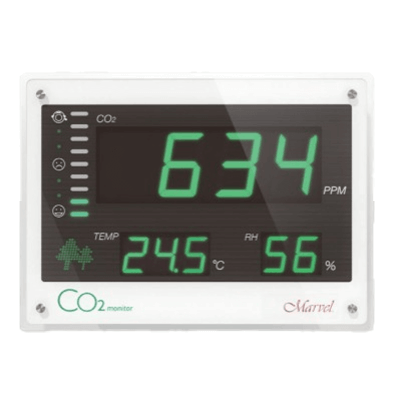What Are CO2 Monitors?

CO2 Monitors are devices that continuously measure CO2 concentration.
Among devices used for medical purposes to measure CO2 concentration in exhaled breath, those that are portable and display CO2 in real time are often referred to as CO2 Monitors.
The display screen is generally digital with a 7-segment display, and it is recommended that the device be installed in a location that is not easily affected by human exhalation or exhaust gases. Since the atmospheric CO2 concentration is about 0.4%, ppm is used as the unit in most cases.
Uses of CO2 Monitors
CO2 Monitors are widely available on the market and are used in a wide range of applications from offices to agriculture.
- Checking ventilation conditions in offices and conference rooms where many people gather
- Confirmation of CO2 concentration for plants in plastic greenhouses
- Confirmation of CO2 concentration in densely populated areas such as retail stores and restaurants
- Confirmation of ventilation conditions in home rooms
- Analysis of exhaust gas from boilers and automobiles
Insufficient ventilation can cause headaches and other adverse effects, so measuring CO2 concentration is often used as a guide. They need to be supplied with CO2 regularly by carbon dioxide gas.
Principles of CO2 Monitors
Widely used CO2 Monitors are NDIR (Non-Dispersive Infrared Radiation Concentration) type, taking advantage of the fact that CO2 absorbs infrared radiation of its own frequency and does not interfere with N2 and O2, the main components in the atmosphere. The NDIR type has become the mainstream because it has a simpler structure and can be made smaller than other measuring devices.
In the case of the NDIR type, the measuring instrument mainly consists of a light source, a sample cell, an infrared detector, and an indicator. The light source emits infrared light with a wavelength that CO2 absorbs, and irradiates it to the infrared detector via the sample cell. When air containing CO2 flows into the sample cell, infrared rays are absorbed in a form that corresponds to the CO2 concentration. It then converts and outputs to CO2 concentration according to the amount of infrared absorption.
N2 and O2, which are the main components of the air, do not absorb infrared rays, so selective detection is possible, but water vapor and CO absorb infrared rays of the same wavelength, causing interference in the measurement. a light source, it is not suitable for measurement of dirty air such as flue gas.
Types of CO2 Monitors
There are several types of NDIR CO2 Monitors, depending on the number and type of light sources.
1. Single-Beam Type
Single-beam CO2 Monitors have only one light source. Since there is no light source to compare it with, it outputs more CO2 concentration when the light emission is weakened due to light source deterioration over time or dust volume. However, it has the advantage of being inexpensive to manufacture due to its simple structure.
2. Two-Light-Source System
The two-beam method uses two light sources and compares both to perform correction. Compared to the single-beam method, this method can compensate for light source deterioration over time, enabling accurate data to be measured. However, it has the disadvantage of requiring two light sources, which increases the number of parts and increases the risk of failure.
3. Double-Beam Type
The double-beam method uses infrared rays of two wavelengths to measure CO2.
By comparing the two wavelengths, the light source degradation over time can be compensated for, enabling accurate CO2 measurement.
This method has fewer components than the two-light-source method and can measure CO2 concentration more accurately than the single-beam method.
Other Information on CO2 Monitors
CO2 Monitors Other Than NDIR
Solid electrolyte CO2 Monitors other than NDIR are available, which use the chemical equilibrium relationship between CO2 and Na2CO3 to measure the electromotive force generated by the increase or decrease of sodium ions in the solid electrolyte, and convert it to CO2 concentration.
However, while it is less susceptible to interference from other components, its disadvantage is that it is affected by temperature and humidity.